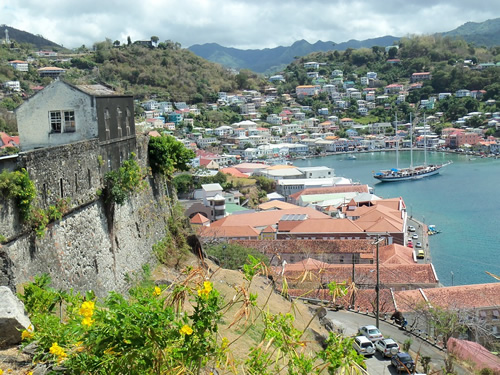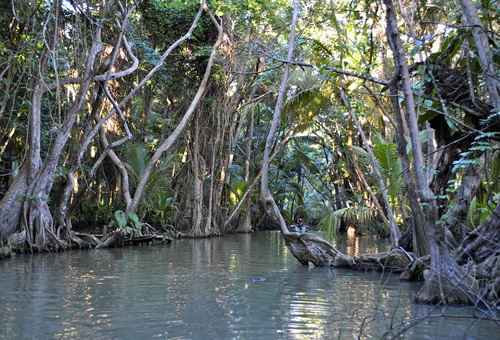Travel on the Island of Dominica
Explore the Thousand Shades of Green
By Peggy Coonley
 |
| A port on the island of Dominica. |
Dominica (pronounced Dom-in-eek-a), bills itself as “the nature island of the Caribbean” for good reason. Its spectacular lush and varied flora and fauna are protected by an extensive natural park system, it is the most mountainous island of the Lesser Antilles, its volcanic peaks are cones of lava craters, and the island is characterized by wonders like Boiling Lake, the second-largest thermally active lake in the world.
Water is everywhere on the island. Dominica boasts 365 rivers and numerous waterfalls; its marine habitat is replete with coral, seahorses, and warm sea vents; and, there’s a year-round population of sperm whales residing in the depths of the ocean surrounding the island.
Despite its abundant natural assets, Dominica has been largely overlooked among its Caribbean neighbors, because of its rocky shoreline, the absence of an international airport, and its mostly black-sand beaches.
Dominica was the last of the Caribbean islands to be colonized by Europeans due chiefly to the fierce resistance of the native Caribs. Some 3,000 Carib (Kalinago) Indians still living on Dominica are the only pre-Columbian populations remaining in the eastern Caribbean, and they contribute to the rich cultural heritage of the island.
Today, like so many island destinations, Dominica’s future hangs in a delicate balance. As the government promotes travel to the island, Dominica has a ripe opportunity to create a pathway from relative poverty to economic stability. But the question will be whether development is carefully and sustainably planned, with thoughtful dialogue from all stakeholders: the native people, the government, and those in the tourism industry. One thing is certain, eco-conscious travelers are discovering Dominica and embracing her warm-spirited people.
 |
| A rainforest in Dominica. |
My seat was by the window on the prop plane from San Juan, Puerto Rico. Daydreaming, I was not prepared for the pristine beauty as we approached the lush mountainous island of Dominica in the West Indies. Like bush pilots, we glided over the tree tops, flowing rivers, and rainforests with a thousand shades of green to a landing at Melville Hall, the tiny airport for this gem of an island called Dominica.
Situated between Guadeloupe and Martinique, folks say if Christopher Columbus sailed the Caribbean waters through the Windward Islands today, Dominica is the only island he might easily recognize. Unspoiled with its abundant biodiversity and spared high-rise hotels and condo developments, Dominica is indeed ready for sustainable tourism and responsible travelers who appreciate the island’s numerous rivers, waterfalls, and endless hiking trails. This quiet island is a nature lover’s dream — fragile enchantment. The native people need sustainable tourism, as the island is switching from an agricultural economy with the demise of the banana trade.
After greeting our driver nicknamed “Brother,” who offered us freshly pressed cold sorrel juice, we loaded into the van and were off to Jungle Bay, a relatively new eco-lodge. Built into a cliff-side jungle, it overlooks the Atlantic Ocean on the south east of the island. Dominica is long and wide and is home to the Morne Trois Pitons National Park which has been designated a UNESCO World Heritage Site. The primary road takes us through the heart of the mountains. The views are stunning, even with one-lane roads peppered with potholes, beeping horns on the turns, and a notable absence of guardrails.
After bumping along and stopping for photo shoots, we arrived at Jungle Bay where we were delivered to our wooden tree top cottages. The New York Times and Conde Nast Traveler have hailed Jungle Bay for its eco-sensibilities, and certainly the visit there was indeed organically luxe. The cliffside spa, wood and stone yoga studio, and the volcanic rock pool all harmonized with the hillside setting overlooking the turquoise ocean.
Our meals were freshly prepared with thoughtful attention to quality. The use of the freshest fish, locally grown organic fruits and vegetables and dedicated, Dominican kitchen staff all made for interesting dining with tasty dishes like callaloo soup and pumpkin pie.
We were six women traveling with Serendipity Traveler, a small company that offers inspired travel for women. As the owner of Serendipity Travel, I view travel as a tool for transformation, renewal, and wellbeing. Each day we chose from a variety of options including hikes, snorkeling, and ocean kayaking. Whenever we were touring our guides, Moses or Irving, would always take time to teach us about the native trees, fruits, and herbs. We visited mineral pools, swam under waterfalls, and attended wellbeing workshops. The abundance of nature slowed our minds, revitalized our spirits, and awakened our senses.
Part of Serendipity Traveler’s mission includes travel philanthropy. We visited the House of Hope in the nearby village of Delicies. After spending a morning with the director, Mr. Heskeith Alexander, two of the caretakers, and three of the severely handicapped children they look after, we left with a commitment to support their dream of building a 12-room facility for orphans, those with physical and mental challenges, as well as others in need of constant care.
We left Dominica as travelers having been touched by the generosity and warmth of the islanders who have little economically yet exude lives of vibrancy and hopefulness.
For More Info
To travel to Dominica the easiest connection is through San Juan, Puerto Rico, to Melville Hall Airport.
|
Peggy Coonley is founder of the travel operator called Serendipity Traveler. When not traveling, she spends time with family in Rockport, Mass., and Lunenburg, Nova Scotia, Canada.
|
